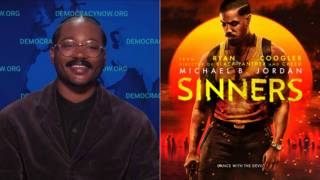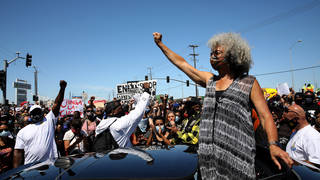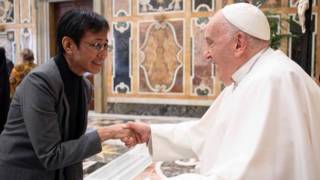
New Orleans has removed the last of four Confederate statues in recent weeks. Workers wore bulletproof vests and face coverings to conceal their identities as they used a crane to remove the statue from its pedestal. New Orleans Mayor Mitch Landrieu said threats and intimidation necessitated the overnight work and extra safety precautions. White nationalists have staged a series of protests and issued threats in the lead-up to the memorials’ removals. Though the four most prominent Confederate monuments have been removed, activists are calling for New Orleans officials to remove all monuments, school names and street signs in the city dedicated to white supremacists. We speak with Malcolm Suber, co-founder of Take ’Em Down NOLA.
Transcript
JUAN GONZÁLEZ: We begin today’s show in New Orleans, where on Friday the city removed the last of four Confederate statues in recent weeks. Hundreds of people gathered to celebrate as the massive bronze statue of Confederate General Robert E. Lee came down. It was the first of a series of monuments to be removed during daylight. Workers wore bulletproof vests and face coverings to conceal their identities as they used a crane to remove the statue from a 60-foot-high pedestal. New Orleans Mayor Mitch Landrieu said threats and intimidation necessitated the overnight work and extra safety precautions. Afterward, Landrieu delivered an address about the city’s efforts to remove the monuments, that he says celebrate the “Lost Cause of the Confederacy.”
MAYOR MITCH LANDRIEU: The historic record is clear: Robert E. Lee, Jeff Davis, P.G.T. Beauregard statues were not erected to just honor these men, but as part of a movement which became known as the cult of the Lost Cause. This cult had one goal and one goal only: through monuments and through other means, to rewrite history, to hide the truth, which is that the Confederacy was on the wrong side of humanity. First erected 166 years after the founding of our cities, 19 years after the Civil War, these monuments that we took down were meant to rebrand the history of our city and the ideals of the Confederacy. …
These statues are not just stone and metal. They’re not just innocent remembrances of a benign history. These monuments celebrate a fictional, sanitized Confederacy, ignoring the death, ignoring the enslavement, ignoring the terror that it actually stood for. And after the Civil War, these monuments were part of that terrorism, as much as burning a cross on someone’s lawn. They were erected purposefully to send a strong message to all who walked in the shadows about who was still in charge in this city.
AMY GOODMAN: White nationalists have staged a series of protests and issued threats in the lead-up to the memorials’ removals. A car belonging to one of the workers had also been set on fire. Though the four most prominent Confederate monuments have been removed, activists are calling for New Orleans officials to remove all monuments, school names and street signs in New Orleans dedicated to white supremacists.
Well, for more, we go to New Orleans, where we’re joined by Malcolm Suber, co-founder and coordinator with Take ’Em Down NOLA.
Welcome to Democracy Now!, Malcolm. Can you talk about the history of the Take ’Em Down movement and your reaction to these four statues being taken down?
MALCOLM SUBER: Yes. Well, you know, first of all, Take ’Em Down NOLA is a continuation of the decades-long struggle of black people in this city to rid ourselves of the presence of these white supremacy monuments. Take ’Em Down NOLA was founded two-and-a-half years ago, and in the wake of the Bree Newsome taking down the Confederate flag in South Carolina and the shootings in Charleston. And we felt that it was necessary for us to come together and really press the city to step up its efforts or renew our efforts to get rid of these white supremacy monuments.
And so, just coincidentally, the mayor announced that he wanted to get rid of four statues around the same time. And from the very beginning, our position was, we are not satisfied with you just saying that there will—the mayor saying that there would only be four statues removed, when we knew, due to our historical research, that there were more than 20 Confederate statues, hundreds of street names and 30 school names. So, in all, there was 130 or 140 Confederate memorials in the city that needed to be removed. And so, our position with the mayor has been, if you truly believe that these Confederate memorials are here to terrorize and to remind black people about who is in charge in the city, then you should expand your reach. And as far as we’re concerned, we, of course, welcome these four being down, but we’ve got plenty of work to do. And we’re asking the mayor to join us in this effort, rather than ask us to be satisfied with these four.
JUAN GONZÁLEZ: And, Malcolm Suber, your reaction to the—the Louisiana House just passed a bill that would make it more difficult to remove any monuments honoring war heroes, including Confederate monuments. Your reaction to those actions of the Legislature and also the threats that have come against the city just for those few monuments that have been removed?
MALCOLM SUBER: Well, you know, we think, of course, the whole history of white supremacist organizations in the South has been one of terrorism. And so, even though they don’t march in the streets with sheets any longer, they have organized themselves and are still issuing all kinds of threats against myself, against the city officials and everybody else who they can think of. But again, history proceeds, and we are not afraid to challenge these white supremacist institutions.
And, of course, a real reflection of how bad race relations are in the state of Louisiana and in New Orleans is that every white legislator in the Louisiana House or Representatives voted last Monday to require a popular vote to have any of these Confederate statues removed, especially of any soldier, including those who were traitors who fought in the Confederate Army. So that, of course, revealed that their true position was to support white supremacy. And as a result of that, all of the—all 23 of the black representatives walked out after the vote and rightly and justifiably called this another white supremacist assault against black people in the state.
AMY GOODMAN: I want to turn back to New Orleans Mayor Mitch Landrieu speaking last week about the efforts to remove the four monuments to the Confederacy.
MAYOR MITCH LANDRIEU: We forget, we deny how much we really depend on each other, how much we really need each other. We justify our silence and inaction by manufacturing noble causes that marinate in historic denial. We still find a way to say, “Wait, wait, wait, not so fast.” Dr. Martin Luther King Jr. said, “'Wait' has almost always meant 'never.'” We cannot wait any longer. We need to change, and we need to change now. No more waiting. This is not just about statues. This is about attitudes. And it’s about behaviors, as well. If we take down these statues and don’t change to become a more open and inclusive society, then all of this would have been in vain.
AMY GOODMAN: Malcolm Suber, if you can respond to the mayor of New Orleans?
MALCOLM SUBER: Well, of course, we say, if you really do believe Mayor Landrieu, if you really do believe that we can’t wait and we should get rid of all these statues, then you’ve got to extend that reach to get rid of all of them. Let’s go forward with a clean slate. Let’s get rid of all the Confederate street names, all the Confederate names on our schools and the rest of the Confederate statues. We just believe there is some inconsistency in the mayor’s position. If he really believes what he says and is not just putting words out for public consumption, then he should join Take ’Em Down NOLA and put a timetable as to when we would get all these things done. And then we can celebrate and go forward and talk about beginning to really address the many problems of the black community here, including 50 percent male unemployment, including 50 percent of our children live in poverty, and, of course, New Orleans is the most incarcerated place in the entire world.
JUAN GONZÁLEZ: I wanted to ask you about the lieutenant—your lieutenant governor, Billy Nungesser, who has asked—
MALCOLM SUBER: Nungesser.
JUAN GONZÁLEZ: Nungesser, who has asked New Orleans Mayor Mitch Landrieu to turn over the Confederate monuments to his office. He met with Landrieu, but city officials said the state would have to submit their proposals for acquiring the monuments along with any other interested groups. This is the lieutenant governor speaking on Monday.
LIEUTENANT GOVERNOR BILLY NUNGESSER: I just want to do the right thing with them. And I think dragging this thing out is not to the better—is not helping tourism. It’s not helping the city. And it’s truly not helping the state. So, I think the people that are passionate about preserving history, those people want to feel comfortable that they’re going to not sit in a yard somewhere, not—not be put back up where visitors from all over the world can come see the history of Louisiana. And that’s what we’re hoping for.
JUAN GONZÁLEZ: That was Lieutenant Governor Nungesser. Your response to him?
MALCOLM SUBER: Well, Billy Nungesser is a white supremacist, believes in white supremacy. And we don’t believe—we don’t take seriously his argument that tourists come to New Orleans to bathe themselves in white supremacy. People come to New Orleans to enjoy the vibrancy of our city, its food, its culture. And very few people come here out of any love or desire to learn about the history of the enslavement of African people and the oppression of African people in the Jim Crow era. So we think these are all thinly veiled arguments to support white supremacy. And our position in Take 'Em Down NOLA is that not only should these things be removed, but they should be destroyed. We don't think that they should be on public display in any context, because, like the mayor said, these things were put up purposely to celebrate white supremacy and the oppression of another people. And we don’t think that the city should be going forward, getting ready to celebrate its 300th birthday—that it should be going forward with a clean slate, getting rid of all Confederate monuments.
AMY GOODMAN: I want to turn to Bryan Stevenson, executive director of the Equal Justice Initiative, speaking about the findings of their 2015 report, “Lynching in America: Confronting the Legacy of Racial Terror.” He called for the placement of historical markers at sites where lynchings occurred.
BRYAN STEVENSON: This idea that racial difference can make you a target of violence and terrorism is something that we’ve been dealing with for a very long time, and I think we just haven’t really talked about it. And one of the things we want to do by erecting these markers and monuments is to get communities to begin to reflect more soberly on what this history represents. You go to Germany now, and you are forced to deal with the legacy of the Holocaust, because there are markers and monuments everywhere. We do the opposite in this country. We celebrate the things, in my judgment, that we probably shouldn’t be celebrating. In all of these states, you find Confederate memorials and monuments everywhere, dedicated to the people who were defending slavery, trying to preserve slavery, and yet nothing about the pain and anguish and suffering and injustice that those institutions created.
AMY GOODMAN: So that was Bryan Stevenson of Equal Justice Initiative. He was speaking to us from Montgomery, Alabama, on Democracy Now! Malcolm Suber, your response to what Bryan is saying?
MALCOLM SUBER: We agree completely with what Bryan is saying. You know, these memorials, all across the South, in every courthouse, in every county, throughout the South, they’ve got a Confederate soldiers’ monument. And they don’t teach our kids in schools that these people were indeed traitors. And, of course, the United States made some fundamental errors after Reconstruction. First of all, the battle flags and these traitors should not have been allowed to participate in the politics of this country. And because of that legacy, instead of doing as they have done in Germany and outlawing all these things that are reminders of the enslavement of African people, they celebrate it. And as long as they celebrate it, they won’t ever understand that these things are daily insults to African people and to our allies and that they must be gotten rid of, if we’re going to move forward on the basis of freedom and equality.
AMY GOODMAN: Malcolm Suber, we want to thank you for being with us, co-founder and coordinator with Take ’Em Down NOLA. This is Democracy Now! When we come back, we go to Jerusalem. Stay with us.













Media Options